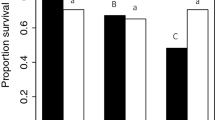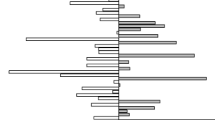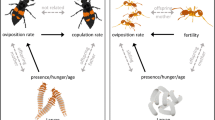Abstract
Life history theory predicts a trade-off between male sexual trait expression and immunocompetence. Using burying beetles, Nicrophorus vespilloides, as a model, we investigated the relationship between male immune function, sex pheromone emission, and attractiveness under field conditions. In the first experiment, we tested whether there is a positive correlation between immune capacity, sex pheromone characteristics (quantity, relative composition, and time invested in pheromone emission), and male attractiveness. As a measurement of immune capacity, we used an individual’s encapsulation ability against a novel antigen. In the second experiment, we specifically examined whether a trade-off between chemical trait expression and immune function existed. To this end, we challenged the immune system and measured the subsequent investment in sex pheromone emission and the attractiveness of the male under field conditions. We found that a male’s immunocompetence was neither related to the emission of the male’s sex pheromone nor to its attractiveness in the field. Furthermore, none of the immune-challenge treatments affected the subsequent investment in pheromone emission or number of females attracted. However, we showed that the same males that emitted a high quantity of their sex pheromone in the laboratory were able to attract more females in the field. Our data suggest that the chemical signal is not a reliable predictor of a male’s immunocompetence but rather is a general important fitness-related trait, with a higher emission of the sex pheromone measured in the laboratory directly affecting the attractiveness of a male under field conditions.








Similar content being viewed by others
References
Ahtiainen JJ, Alatalo RV, Kortet R, Rantala MJ (2004) Sexual advertisement and immune function in an arachnid species (Lycosidae). Behav Ecol 15:602–606
Ahtiainen JJ, Alatalo RV, Kortet R, Rantala MJ (2005) A trade-off between sexual signalling and immune function in a natural population of the drumming wolf spider Hygrolycosa rubrofasciata. J Evolution Biol 18:985–991
Ali JG, Tallamy DW (2010) Female spotted cucumber beetles use own cuticular hydrocarbon signature to choose immunocompatible mates. Anim Behav 80:9–12
Andersson MB (1994) Sexual selection. Princeton University Press, Princeton
Arce AN, Johnston PR, Smiseth PT, Rozen DE (2012) Mechanisms and fitness effects of antibacterial defences in a carrion beetle. J Evolution Biol 25:930–937
Baer B, Armitage SAO, Boomsma JJ (2006) Sperm storage induces an immunity cost in ants. Nature 441:872–875
Balenger SL, Zuk M (2014) Testing the Hamilton–Zuk hypothesis: past, present, and future. Integr Comp Biol 54:601–613
Beeler AE, Rauter CM, Moore AJ (1999) Pheromonally mediated mate attraction by males of the burying beetle Nicrophorus orbicollis: alternative calling tactics conditional on both intrinsic and extrinsic factors. Behav Ecol 10:578–584
Chemnitz J, Jentschke PC, Ayasse M, Steiger S (2015) Beyond species recognition: somatic state affects long-distance sex pheromone communication. Proc R Soc B 282:20150832
Chemnitz J, Bagrii N, Ayasse M, Steiger S (2017) Staying with the young enhances the fathers’ attractiveness in burying beetles. Evolution 71: 985–994
Contreras-Garduño J, Canales-Lazcano J, Córdoba-Aguilar A (2006) Wing pigmentation, immune ability, fat reserves and territorial status in males of the rubyspot damselfly, Hetaerina americana. J Ethol 24:165–173
Cotter SC, Kilner RM (2010a) Personal immunity versus social immunity. Behav Ecol 21:663–668
Cotter SC, Kilner RM (2010b) Sexual division of antibacterial resource defence in breeding burying beetles, Nicrophorus vespilloides. J Anim Ecol 79:35–43
Cotter SC, Topham E, Price AJ, Kilner RM (2010) Fitness costs associated with mounting a social immune response. Ecol Lett 13:1114–1123
Cotter SC, Ward RJS, Kilner RM (2011) Age-specific reproductive investment in female burying beetles: independent effects of state and risk of death. Funct Ecol 25:652–660
Cotter SC, Littlefair JE, Grantham PJ, Kilner RM (2013) A direct physiological trade-off between personal and social immunity. J Anim Ecol 82:846–853
Drayton JM, Hall MD, Hunt J, Jennions MD (2012) Sexual signaling and immune function in the black field cricket Teleogryllus commodus. PLoS One 7:e39631
Drayton JM, Boeke JK, Jennions MD (2013) Immune challenge and pre-and post-copulatory female choice in the cricket Teleogryllus commodus. J Insect Behav 26:176–190
Eggert A (1992) Alternative male mate-finding tactics in burying beetles. Behav Ecol 3:243–254
Eggert A, Müller JK (1989) Mating success of pheromone-emitting Necrophorus males: do attracted females discriminate against resource owners? Behaviour 110:248–257
Eggert A, Müller JK (1997) Biparental care and social evolution in burying beetles: lessons from the larder. In: Choe JC, Crespi BJ (eds) The evolution of social behavior in insects and arachnids. Cambridge University Press, Cambridge, pp 216–236
Folstad I, Karter AJ (1992) Parasites, bright males, and the immunocompetence handicap. Am Nat 132:603–622
Foster SP, Johnson CP (2011) Signal honesty through differential quantity in the female-produced sex pheromone of the moth Heliothis virescens. J Chem Ecol 37:717–723
Freitak D, Ots I, Vanatoa A, Hörak P (2003) Immune response is energetically costly in white cabbage butterfly pupae. P Roy Soc Lond B Biol 270:20030069
Gershman SN, Barnett CA, Pettinger A, Weddle CB, Hunt J, Sakaluk SK (2010) Inbred decorated crickets exhibit higher measures of macroparasitic immunity than outbred individuals. Heredity 105:282–289
Gilbert R, Karp RD, Uetz GW (2016) Effects of juvenile infection on adult immunity and secondary sexual characters in a wolf spider. Behav Ecol 27:946–954
Gillespie JP, Kanost MR, Trenczek T (1997) Biological mediators of insect immunity. Annu Rev Entomol 42:611–643
González-Santoyo I, Córdoba-Aguilar A, González-Tokman DM, Lanz-Mendoza H (2010) Phenoloxidase activity and melanization do not always covary with sexual trait expression in Hetaerina damselflies (Insecta: Calopterygidae). Behaviour 147:1285–1307
González-Tokman DM, Córdoba-Aguilar A (2010) Survival after experimental manipulation in the territorial damselfly Hetaerina titia (Odonata: Calopterygidae): more ornamented males are not more pathogen resistant. J Ethol 28:29–33
Haberer W, Schmitt T, Peschke K, Schreier P, Müller JK (2008) Ethyl 4-methyl heptanoate: a male-produced pheromone of Nicrophorus vespilloides. J Chem Ecol 34:94–98
Haberer W, Schmitt T, Schreier P, Müller JK (2011) Intended and unintended receivers of the male pheromones of the burying beetles Nicrophorus humator and Nicrophorus vespilloides. Entomol Exp Appl 140:122–126
Hamilton WD, Zuk M (1982) Heritable true fitness and bright birds: a role for parasites? Science 218:384–387
Harari AR, Zahavi T, Thiéry D (2011) Fitness cost of pheromone production in signaling female moths. Evolution 65:1572–1582
Höglund J, Sheldon BC (1998) The cost of reproduction and sexual selection. Oikos:478–483
Jacobs CGC, Steiger S, Heckel DG, Wielsch N, Vilcinskas A, Vogel H (2016) Sex, offspring and carcass determine antimicrobial peptide expression in the burying beetle. Sci Rep 6:25409
Jacot A, Scheuber H, Brinkhof MWG (2004) Costs of an induced immune response on sexual display and longevity in field crickets. Evolution 58:2280–2286
Johansson BG, Jones TM (2007) The role of chemical communication in mate choice. Biol Rev 82:265–289
Kerr AM, Gershman SN, Sakaluk SK (2010) Experimentally induced spermatophore production and immune responses reveal a trade-off in crickets. Behav Ecol 035:647–654
Ketola T, Kortet R, Kotiaho JS (2009) Endurance in exercise is associated with courtship call rate in decorated crickets, Gryllodes sigillatus. Evol Ecol Res 11:1131–1139
Kokko H (1997) Evolutionarily stable strategies of age-dependent sexual advertisement. Behav Ecol Sociobiol 41:99–107
Kurtz J (2007) The correlation between immunocompetence and an ornament trait changes over lifetime in Panorpa vulgaris scorpionflies. Zoology 110:336–343
Lawniczak MKN, Barnes AI, Linklater JR, Boone JM, Wigby S, Chapman T (2007) Mating and immunity in invertebrates. Trends Ecol Evol 22:48–55
Leman JC, Weddle CB, Gershman SN, Kerr A, Ower GD, St John JM, Vogel L, Sakaluk SK (2009) Lovesick: immunological costs of mating to male sagebrush crickets. J Evolution Biol 22:163–171
Loker ES, Adema CM, Zhang S, Kepler TB (2004) Invertebrate immune systems—not homogeneous, not simple, not well understood. Immunol Rev 198:10–24
Moret Y, Schmid-Hempel P (2000) Survival for immunity: the price of immune system activation for bumblebee workers. Science 290:1166–1168
Müller JK, Eggert AK (1987) Effects of carrion-independent pheromone emission by male burying beetles (Silphidae: Necrophorus). Ethology 76:297–304
Mulrey TEP, Eggert A, Sakaluk SK (2015) Switching tactics: phenotypic plasticity in the alternative mate-finding tactics of burying beetles. Anim Behav 108:175–182
Nielsen ML, Holman L (2012) Terminal investment in multiple sexual signals: immune-challenged males produce more attractive pheromones. Funct Ecol 26:20–28
Nunn CL, Lindenfors P, Pursall ER, Rolff J (2009) On sexual dimorphism in immune function. Philos T Roy Soc B 364:61–69
Palmer WJ, Duarte A, Schrader M, Day JP, Kilner RM, Jigging FM (2016) A gene associated with social immunity in the burying beetle Nicrophorus vespilloides. Proc R Soc B 283:20152733
Pomfret JC, Knell RJ (2006) Immunity and the expression of a secondary sexual trait in a horned beetle. Behav Ecol 17:466–472
Pukowski E (1933) Ökologische Untersuchungen an Necrophorus F. Zoomorphology 27:518–586
R Core Team (2014) R: A Language and Environment for Statistical Computing. R Foundation for Statistical Computing, Vienna
Rantala MJ, Kortet R (2003) Courtship song and immune function in the field cricket Gryllus bimaculatus. Biol J Linn Soc 79:503–510
Rantala MJ, Koskimäki J, Taskinen J, Tynkkynen K, Suhonen J (2000) Immunocompetence, developmental stability and wingspot size in the damselfly Calopteryx splendens L. P Roy Soc Lond B Biol 267:2453–2457
Rantala MJ, Jokinen I, Kortet R, Vainikka A, Suhonen J (2002) Do pheromones reveal male immunocompetence? P Roy Soc Lond B Biol 269:1681–1685
Rantala MJ, Kortet R, Kotiaho JS, Vainikka A, Suhonen J (2003a) Condition dependence of pheromones and immune function in the grain beetle Tenebrio molitor. Funct Ecol 17:534–540
Rantala MJ, Vainikka A, Kortet R (2003b) The role of juvenile hormone in immune function and pheromone production trade-offs: a test of the immunocompetence handicap principle. P Roy Soc Lond B Biol 270:2257–2261
Roberts ML, Buchanan KL, Evans (2004) Testing the immunocompetence handicap hypothesis: a review of the evidence. Anim Behav 68:227–239
Roved J, Westerdahl H, Hasselquist D (2016) Sex differences in immune responses: hormonal effects, antagonistic selection, and evolutionary consequences. Hormones and Behavior 88:95–105
Rozen DE, Engelmoer DJ, Smiseth PT (2008) Antimicrobial strategies in burying beetles breeding on carrion. Proc Natl Acad Sci 105:17890–17895
Ryder JJ, Siva-Jothy MT (2000) Male calling song provides a reliable signal of immune function in a cricket. P Roy Soc Lond B Biol 267:1171–1175
Scott MP (1998) The ecology and behavior of burying beetles. Annu Rev Entomol 43:595–618
Sheldon BC, Verhulst S (1996) Ecological immunology: costly parasite defences and trade-offs in evolutionary ecology. Trends Ecol Evol 11:317–321
Sileshi G, Hailu G, Nyadzi GI (2009) Traditional occupancy–abundance models are inadequate for zero-inflated ecological count data. Ecol Model 220:1764–1775
Simmons LW, Zuk M, Rotenberry JT (2005) Immune function reflected in calling song characteristics in a natural population of the cricket Teleogryllus commodus. Anim Behav 69:1235–1241
Siva-Jothy MT (2000) A mechanistic link between parasite resistance and expression of a sexually selected trait in a damselfly. P Roy Soc Lond B Biol 267:2523–2527
Siva-Jothy MT, Thompson JJW (2002) Short-term nutrient deprivation affects immune function. Physiol Entomol 27:206–212
Siva-Jothy MT, Tsubaki Y, Hooper RE, Plaistow SJ (2001) Investment in immune function under chronic and acute immune challenge in an insect. Physiol Entomol 26:1–5
Steiger S, Stökl J (2014) The role of sexual selection in the evolution of chemical signals in insects. Insects 5:423–438
Steiger S, Gershman SN, Pettinger AM, Eggert A, Sakaluk SK (2011) Sex differences in immunity and rapid upregulation of immune defence during parental care in the burying beetle, Nicrophorus orbicollis. Funct Ecol 25:1368–1378
Steiger S, Gershman SN, Pettinger AM, Eggert A, Sakaluk SK (2012) Dominance status and sex influence nutritional state and immunity in burying beetles Nicrophorus orbicollis. Behav Ecol 082:1126–1132
Vainikka A, Rantala MJ, Seppälä O, Suhonen J (2007) Do male mealworm beetles, Tenebrio molitor, sustain the honesty of pheromone signals under immune challenge? Acta Etholog 10:63–72
Williams GC (1966) Natural selection, the costs of reproduction, and a refinement of Lack’s principle. Am Nat 100:687–690
Zuk M (2009) The sicker sex. PLoS Pathog 5:e1000267
Zuk M, Simmons LW, Rotenberry JT, Stoehr AM (2004) Sex differences in immunity in two species of field crickets. Can J Zool 82:627–634
Acknowledgments
We thank three anonymous reviewers for their helpful comments. The study was funded by a grant from the German Research Foundation (DFG) to SS (STE 1874/3-1) and a PhD grant to JC (1405 LGFG-E).
Author information
Authors and Affiliations
Corresponding author
Additional information
Communicated by: Sven Thatje
Electronic supplementary material
.
ESM 1
(DOCX 86 kb)
Rights and permissions
About this article
Cite this article
Chemnitz, J., Bagrii, N., Ayasse, M. et al. Variation in sex pheromone emission does not reflect immunocompetence but affects attractiveness of male burying beetles—a combination of laboratory and field experiments. Sci Nat 104, 53 (2017). https://doi.org/10.1007/s00114-017-1473-5
Received:
Revised:
Accepted:
Published:
DOI: https://doi.org/10.1007/s00114-017-1473-5




